APES Chapter 14
1/53
Earn XP
Description and Tags
Name | Mastery | Learn | Test | Matching | Spaced |
|---|
No study sessions yet.
54 Terms
Water pollution
The contamination of streams, rivers, lakes, oceans, or groundwater with substances produced through human activities
Wastewater
Water produced by livestock operations and human activities, including human sewage from toilets and gray water from bathing and washing of clothes and dishes
Point source
A distinct location from which pollution is directly produced
Nonpoint source
A diffuse area that produces pollution.
What are the three categories that problems form wastewater fall into
• Oxygen demand
• Nutrient release
• Disease-causing organisms
Oxygen Demand
Biochemical oxygen demand (BOD)
The amount of oxygen a quantity of water uses over a period of time at specific temperatures
Dead zone
In a body of water, an area with extremely low oxygen concentration and very little life.
Nutrient Release
Eutrophication
A phenomenon in which a body of water becomes rich in nutrients
Cultural eutrophication
An increase in fertility in a body of water, the result of anthropogenic inputs of nutrients
Disease-Causing Organisms
Diseases that can be contracted by coming into contact with contaminated water include:
• Cholera
• Typhoid fever
• Stomach flu
• Diarrhea
• Cholera
• Hepatitis
Indicator species
A species that indicates whether or not disease-causing pathogens are likely to be present
Fecal coliform bacteria
A group of generally harmless microorganisms in human intestines that can serve as an indicator species for potentially harmful microorganisms associated with contaminated sewage
Treating wastewater
Two common ways to handle human wastewater:
• Septic systems
• Sewage treatment plants
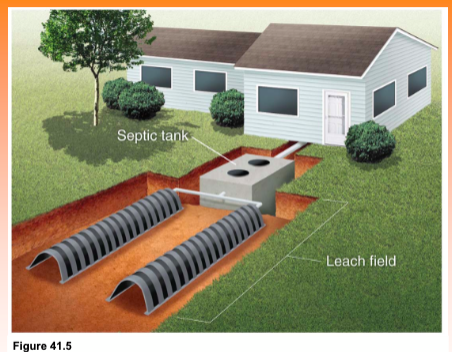
Septic Systems
Septic system
A relatively small and simple sewage treatment system, made up of a septic tank and a leach field, often used for homes in rural area
Spetic Tank
A large container that receives wastewater from a house as part of a septic system
Sludge
Solid waste material from wastewater
Septage
A layer of fairly clear water found in the middle of a septic tank
Leach Field
A component of a septic system, made up of underground pipes laid out below the surface of the ground.
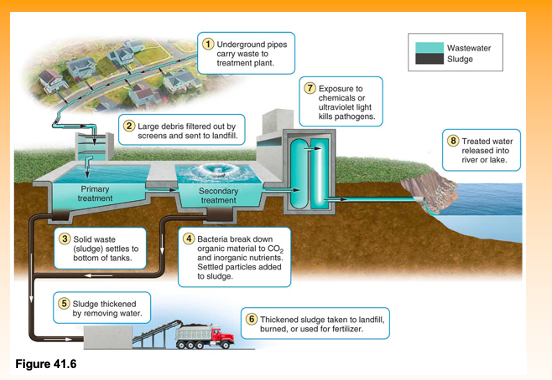
Sewage Treatment Plants
In developed countries, municipalities use centralized sewage treatment plants that receive wastewater from hundreds or even thousands of households.
In traditional waste treatment plants, there are two phases of treatment: primary and secondary
A sewage treatment plant
In large municipalities, great volumes of wastewater are handled by separating the sludge from the water and then using bacteria to break down both components.
Animal Feed Lots and Manure Lagoons
Manure from concentrated animal feeding operations is a problem because of volume. It can also contain hormones and antibiotics that are given to the animals
Manure lagoon
Human-made pond lined with rubber built to handle large quantities of manure produced by livestock
Heavy Metals and Other Chemicals
Lead
found in pipes and other materials in older construction
Arsenic
occurs naturally and through human activity such as mining and industry
Mercury
occurs naturally and through human activity, primarily burning coal
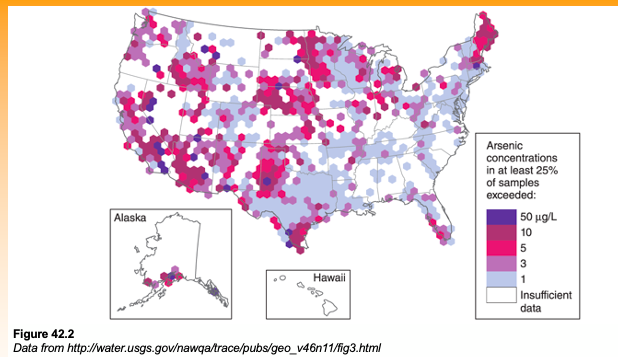
Arsenic in U.S. well water
The highest concentrations of arsenic are generally found in the upper Midwest and the West
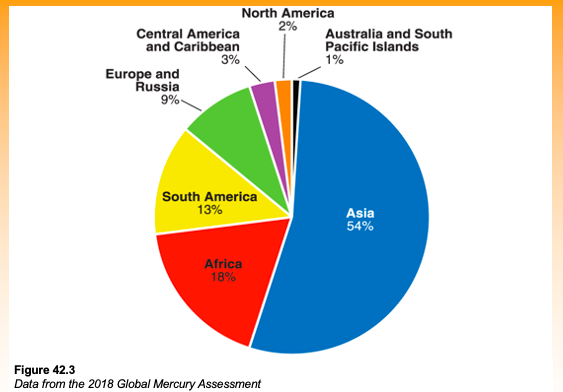
World mercury emissions
Mercury emissions from human activities vary greatly among regions of the world
Acid deposition and acid mine drainage affect terrestrial and aquatic ecosystems
Acid deposition
Acids deposited on Earth as rain and snow or as gases and particles that attach to the surfaces of plants, soil, and water.
Acid deposition occurs when burning coal releases sulfur dioxide and nitrogen dioxide into the air
In the atmosphere, these chemicals are converted to sulfuric acid and nitric acid, which fall back to Earth as acid deposition
Acid deposition reduces the pH of water bodies to levels that are lethal to many organisms
Many coal-burning facilities have installed coal scrubbers to combat this problem
Synthetic organic compounds are human-produced chemicals
Synthetic compounds can enter the water supply from industrial point sources or from nonpoint sources when they are applied over large areas.
These compounds include pesticides, pharmaceuticals, military compounds, and industrial compounds.
Synthetic organic compounds can be toxic, cause genetic defects, and interfere with growth and sexual development.
Contaminants in streams
Streams contain a wide variety of chemicals including pharmaceutical drugs and hormones. These come from a combination of wastewater inputs, agriculture, forestry, and industry
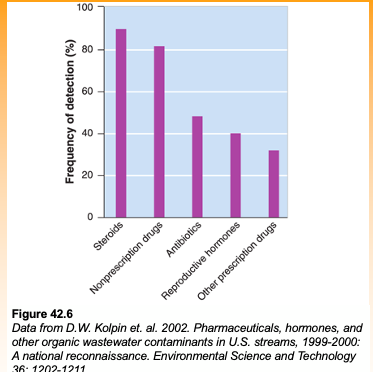
Military Compounds
Perchlorates
A group of harmful chemicals used for rocket fuel. Perchlorates sometimes contaminate the soil in regions of the world where military rockets are manufactured, tested, or dismantled
Industrial Compounds
• Industrial compounds: chemicals used in manufacturing.
• It used to be common for manufacturers in the United States to dump industrial compounds directly into bodies of water
Polychlorinated biphenyls (PCBs)
A group of industrial compounds used to manufacture plastics and insulate electrical transformers, and responsible for many environmental problems.
Oil Pollution
Sources of oil in the ocean
Oil contamination in the ocean, both (a) in North America and (b) worldwide, comes from a variety of sources including natural seeps, extraction of oil from underneath the ocean, transport of oil by tanker or pipeline, and consumption of petroleum-based products.

Ways to remediate oil pollution
Containment: Booms keep the floating oil from spreadig, then boats equipped with giant oil vacuums suck up as much oil as possible
Chemicals: Chemicals break up the oil on the surface, making it disperse before it hits the shoreline
Bacteria: A particular bacterium consumes oil; scientists are currently trying to genetically engineer the bacteria to consume oil even faster
Nonchemical Water Pollution (mod 44)
Solid Waste
Much solid waste is what we call garbage and the sludge produced by sewage treatment plants
Thermal pollution
Non Chemical water pollution that occurs when human activities cause a substantial change in the temperature of water
Thermal shock
A dramatic change in water temperature that can kill organisms
Water Pollution Laws (mod 45)
Clean Water Act
Legislation that supports the “protection and propagation of fish, shellfish, and wildlife and recreation in and on the water” by maintaining and, when necessary, restoring the chemical, physical, and biological properties of surface waters
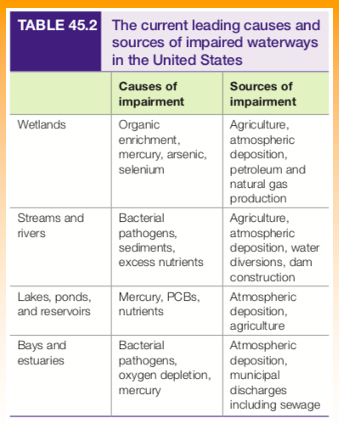
Safe Drinking Water Act
Legislation that sets the national standards for safe drinking water
The Safe Water Drinking Act establishes maximum contaminant levels (MCL) for 77 different elements or substances in both surface water and groundwater
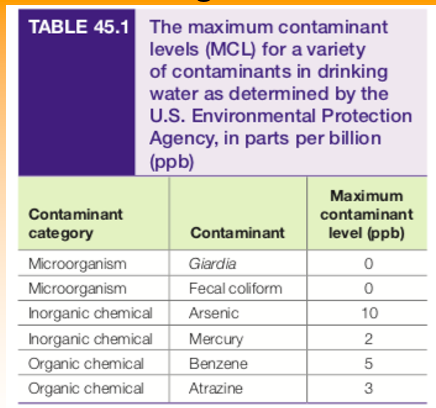
Maximum contaminant level (MCL)
The standard for safe drinking water established by the EPA under the Safe Drinking Water Act.
Water pollution legislation is becoming more common in the
developing world
Developed countries have addressed the problems of pollution by cleaning up polluted areas and by passing legislation to prevent pollution in the future